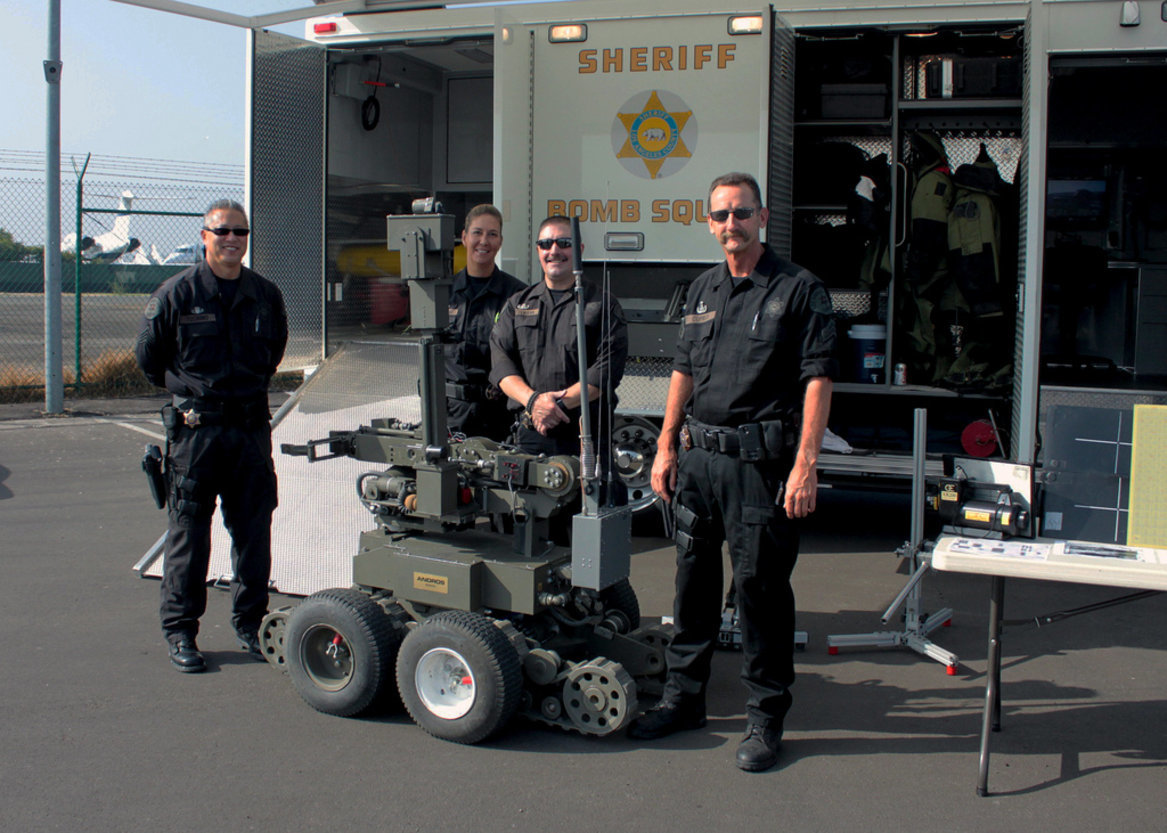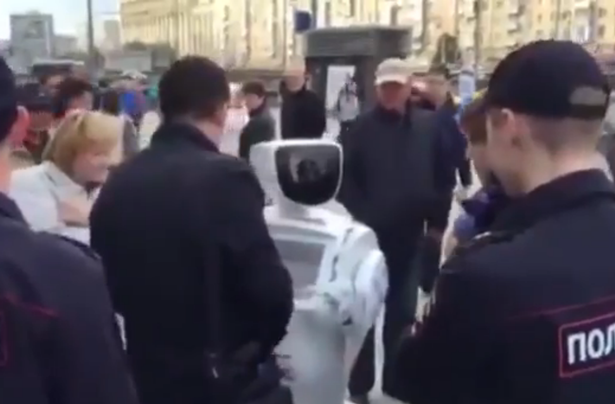Officials said the use of the robot to disarm a violent suspect was unprecedented for the Sheriff's Department, and comes as law enforcement agencies increasingly rely on military-grade technology to reduce the risk of injury during confrontations with civilians.
"The robot was a game changer here," said Capt. Jack Ewell, a tactical expert with the Sheriff's Department — the largest sheriff's department in the nation. "We didn't have to risk a deputy's life to disarm a very violent man."
It began late in the evening of Sept. 8, when deputies in Lancaster were pursuing a man suspected of trying to kill one person and robbing two others.
The suspect, Brock Ray Bunge, 51, fled into a dark, remote field in the Antelope Valley. A sheriff's helicopter eventually tracked him down to a dirt berm, where he holed up surrounded by shrubbery and wire fencing.
Deputies ordered Bunge to surrender several times but he refused. A sheriff's SWAT team arrived with armored vehicles and tried to coax him to surrender for more than six hours.
Eventually, officials deployed the robot to gain a closer view of Bunge's hideout. The camera showed him on his stomach, with his rifle at his feet, Ewell said.
To seize the firearm, they hatched a plan that relied on distractions. Deputies in an armored vehicle approached to the front of Bunge, yelling at him through a public address system to surrender. A helicopter whirred overhead.
From behind, the olive-colored robot approached and extended its claw into Bunge's hideout.
"The robot was able to move up and grab the gun without him noticing," Ewell said. "He never knew it happened."
Deputies quickly reversed the robot and recovered the gun. Then, they sent the device back to the berm and had the robot grab the wire fencing, exposing Bunge's hiding spot.
"He only realized the gun was gone when the robot returned to pull down the wire," Ewell said.
Bunge surrendered immediately.
The Andros robot cost about $300,000, and Ewell said the department typically uses the device for bomb disposal. Increasingly, however, the agency is using the robot during encounters with armed suspects.
"When it saves lives, it is more than worth it," he said.
During the hours-long standoff with Micah Johnson, the killer of five police officers this summer in downtown Dallas, police relied on a small, remote-controlled robot to ferry an explosive device close to the gunman.
Police detonated the device, killing 25-year-old Johnson.
"We saw no other option but to use our bomb robot," Police Chief David Brown said at a news conference. "Other options would have exposed our officers to grave danger."
Last year, sheriff's deputies used a robot during a 22-hour standoff with a woman in Woodland Hills. She twice shot at a police robot that approached her, and eventually crawled under her home. SWAT deputies arrested her after pulling her out.
In April, a standoff with a barricaded man near the state Capitol Building in Sacramento saw police use a robot while attempting to contact the suspect in his car.
After Bunge was taken into custody, the Los Angeles County district attorney's office filed felony charges against him including attempted murder, assault with a deadly weapon, vandalism, robbery and making criminal threats.
He pleaded not guilty to the charges during a court appearance Tuesday and is being held in county jail in lieu of $1.575 million bond, according to court records.
Comment: This story is reminiscent of the first big 'police robot' action to hit national news: Dallas armed robot kill highlights the militarization of American police. It appears we are seeing a new trend in police state tactics - however its spun in 'happy ending' stories like the above one. We can probably expect to see a rise of these machines, and others like drones, as the US police state further corrals the populace into submission.
The next story form the Mirror highlights how robots - even at a relatively low-level of functioning - are beginning to act 'autonomously'.
Notorious runaway robot that has escaped lab twice has been arrested by police at political rally
Police even tried to handcuff the device after a member of public called authorities to complain about the electronic device
A notorious runaway robot - that has escaped from its lab twice - has been arrested by police at a political rally.
Promobot was supporting Russian Parliament candidate Valery Kalachev in Moscow when authorities attempted to handcuff it and take it away.
It is believed that the arrest occurred after a member of public called police as Promobots were recording the opinions of voters on a variety of topics "for further processing and analysis by the candidate's team."
A company spokesman told Inverse magazine: "Police asked to remove the robot away from the crowded area, and even tried to handcuff him.
"According to eyewitnesses, the robot did not put up any resistance."
The robot has hit the headlines in the past, when it escaped from its lab and walked out into oncoming traffic - twice.
It caused chaos on the streets after getting halfway across the road before its batteries ran out, leaving it stranded in the middle of the carriageway.
The robot was on the road outside the research lab for more than an hour as vehicles tried to manoeuvre their way around it.
Promobot - short for Promotional Robot - is a unique robot created by Russian scientists and is designed to work in customer relations.
It is designed to interact with humans realistically, and can answer questions and remember every person it has ever met.
Comment: You'd think that the Russians were tired of dealing with robots in a political context. Oh well.
In other news, we learn of some 'kinder and gentler' robots whose "oh wow!" factor is delighting the technology obsessed and will assist them in their purchase of the new iphone 7. (Maybe some of these folks finally realized how ridiculous it is to wait outside of a store for two days in order to purchase the newest model of gadget. But how does this issue get addressed - with another gadget!
People all over the world are lining up for the iPhone 7 (and iPhone 7 Plus, if they pre-ordered) Friday. But it might surprise you to learn that a bunch of stand-in robots probably got one before you did.
New Zealand-based Apple carrier Spark used robots to queue for the much coveted device, so their human counterparts didn't have to line up for days.
Clive Ormerod of Spark said the project was born of invention and necessity, saying "technology these days is so much more advanced than it used to be, so why shouldn't our customers have their tech queue for them instead?"
The 100 Alpha 1 robots were purchased by Spark for this specific purposes, and have been chilling outside the store since Sept. 9.
The humans assigned to each robot had the option of watching a live stream of the queue from the comfort of their warm, dry home.
Controlled through the customers soon-to-be-replaced phone (via an app), the robots can be commanded to do pushups, kung fu, yoga and even have a casual boogie. As an added incentive, customers also got to keep the bot at the end of it all.
What a time to be alive.





Reader Comments
to our Newsletter